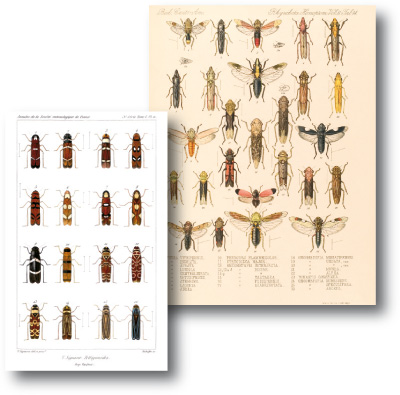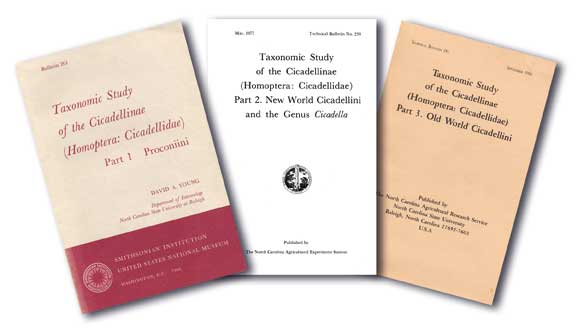- Introduction
- Classification
- Historical study
- Who described the species?
- Specimen depository
- Future research
Enable JavaScript for full functionality

BIOTIR 4
Sharpshooter Leafhoppers
(Hemiptera: Cicadellinae)
An Illustrated Checklist
Part 1: Old World Cicadellini
Hardcover - 232 pages - Full colour throughout
£50.00 (plus P & P)
ORDER
A Brief History of Cicadelline Study
(1758 - 2007)
Linnaeus (1758a) described 4 cicadelline species in the genus Cicada, which included many other Auchenorrhyncha species, such as treehoppers, spittlebugs, planthoppers, and true cicadas. A first attempt to better define the genus Cicada was made by Fabricius (1794a), who transferred some Linnaean species of other Auchenorrhyncha and even some leafhoppers (such as Jassus) to other genera. Following this Germar (1833a) defined the genus Tetigonia Geoffroy (posteriorly emended to Tettigonia by Olivier 1789a, but rejected by the International Commission of Zoological Nomenclature, see Hemming 1954, and currently used as synonymous to Cicadella Latreille, ICZN 1963a) using characters that will mostly define the subfamily Cicadellinae for following authors, such as the tumid frons and the ocelli positioned on the middle of the crown.
 Plates form Signoret's monograph and
Plates form Signoret's monograph and
Fowler's “Biologia Centrali Americana”.
Since Linnaeus (1758a) about 2,790 species have been described in the tribes Cicadellini and Proconiini by around 60 authors. Of the described species, around 2,290 are currently accepted as valid. Signoret (1853b, c, 1854a, b, 1855a, b, c, d) was the first to attempt to monograph the group as it was then understood. He published re-descriptions of a number of species (including those of Walker, with whom he was a contemporary) and described a large number of species, accompanied by colour illustrations. Although Signoret recognized that there were 12 generic names available, including Dilobopterus Signoret, 1850b, which he erected himself, he treated all species in the large genus Tettigonia. He regretfully decided to abandon the previously established genera because he understood their diagnostic characters as part of a continuum, impossible to objectively break down, even though he did assemble Tettigonia species in 5 groups.
Stål (1869) attempted to separate genera and described other new genera in the subfamily. His arrangement was mostly followed by Fowler in a series of papers (1894-1909) in the ‘Biologia Centrali Americana’. This volume was also accompanied by high quality colour illustrations. Fowler treated a number of genera that would all fall into the tribe Proconiini as presently defined. His remaining species were placed in Tettigonia and he covered 160 species (in what would be the tribe Cicadellini). Fowler (1899: 235) also states that: ‘It is possible that the genus may at some future time be divided, but it seems impossible to do this satisfactorily in the present stage of our knowledge’. As with most authors at this period, Fowler was relying on external characteristics, as did also Distant (1908f, 1908g, 1918b) who also described many species from the Oriental region.
Melichar (1924a, 1925a, 1926a, 1932a, 1951a) made a substantial contribution in his monograph- published after his death in 1924. He divided the subfamily into two sections: the Proconiaria with 54 genera and the Cicadellaria with 101 genera, which correspond more or less with the Cicadellini and Proconiini as treated subsequently by Young. The main problem with using Melichar’s classification is that the work is entirely without illustrations.
While further species were described by other workers following Melichar, it was not until Young commenced his work in around 1952 that real progress was made, although the availability of the Metcalf catalogue to the ‘Tettigellinae’ (Metcalf 1964a) would have made progress easier. In the introduction to his monograph on Proconiini (Young 1968a) he states that the need for a generic revision became clear while working for the US Department of Agriculture. Cicadellinae specimens sent for identification could rarely be identified to genus on the basis of existing literature. Young followed previous authors (e.g., Oman 1949a) by utilising characters of the male genitalia to delimiting genera (in addition to using female terminalia as specific diagnostic characters in 1977a and 1986a) and a move to the North Carolina State University provided more research time than available before.
 David Young's Monographs (1968, 1977, 1986)
David Young's Monographs (1968, 1977, 1986)His monographic revisions of the group (Young 1968a, 1977a, 1986a) occupied him for the rest of his career, and has given a remarkable legacy from which all modern work has started. While Young’s intention was to provide a generic framework, he described many new species and also made synonyms based on his studies in European museums. He did not, however, provide a modern phylogenetic analysis of the relationships of the genera, and only gave schematic relationships among genera and groups of genera.
The availability of the monographs has allowed a new generation of specialists, especially in Brazil and China, to describe many new species. Recently some re-analysis of generic and species relationships using phylogenetic analysis both morphological and molecular data and has been carried out in the tribe Proconiini (Takiya, 2007). A new catalogue to the Cicadellinae has been produced (McKamey, 2007) which will make the group further accessible.

